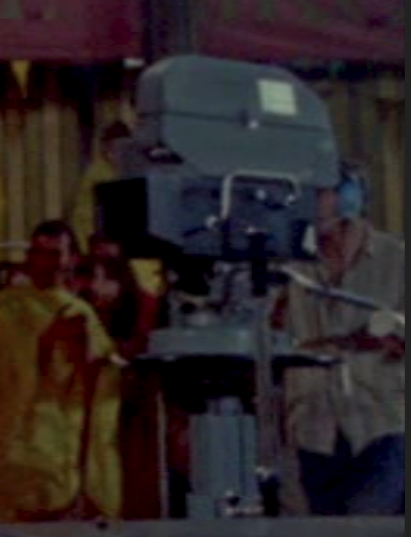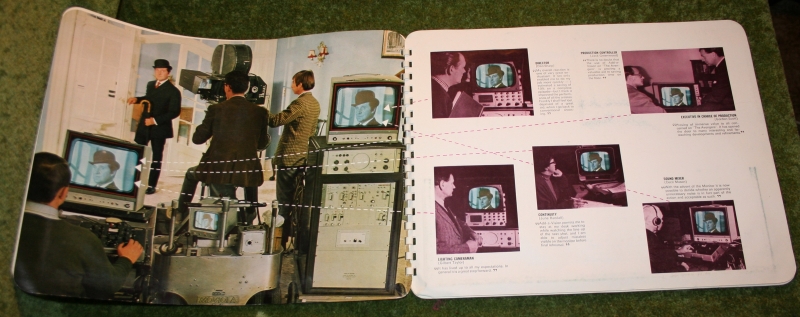“Gemini” was a system that aimed to combine the speed and ease of video recording with the quality of 35mm film. Essentially, a 35mm film camera was mounted alongside a standard television electronic camera. Edit marks were automatically added to the film by a remote feed from the vision mixer’s desk, enabling a film editor to exactly match the video version of the show. See the original Tech Ops page here.
[Ed: please note that variations in spelling the 35mm product name have been changed to “Add-A-Vision”]
Bernie Newnham
Sky Arts is running that Rolling Stones circus concert, recorded (filmed) on these. I think the BBC tried them out at Riverside, but I can’t remember what they were called.

Peter Neill
I think the system was called Gemini.
Dave Mundy
I seem to remember that there were several in the studio and were used like conventional electronic cameras and only ran when cut-up on a mixer! The bits were glued together later – it didn’t seem to last long as an experiment!
Peter Fox
I recall it being known as “Add-A-Vision” Its main problem was that the Union (probably ABS) objected to the use of film cameras without appropriate film department pay grades, since clearly that was the intention, hence deadlock and the equipment remained herded into a cage in the corner of, or next to, a Riverside studio. After months gathering dust it disappeared again. And that was that…
I further found this link to Gerry Anderson and it includes mention of Add-A-Vision towards the end. It’s an interesting read about Thunderbirds et seq anyway
http://www.tvstudiohistory.co.uk/gerry.htm
Pat Heigham
More likely to have been ACTT, or ACT in those days. There seemed to be a Union inspired block on adoption of new technology, probably attempting to maintain crewing strength.
When the IV-S Stereo Nagra appeared, my mixer, Sandy, seized upon it as a wonderful opportunity to record radio mics separately from a boom. However the transfer chaps at Thames wanted double money for transferring two simultaneous tracks to magnetic, demanding that a choice should be made as to which track was to be handled. Not the point at all! What would be the case today with digital recorders offering 16+ track capture?
One feels that the job description has reverted to ‘sound recordist’ as opposed to ‘mixer’ although a rough mix is carried out for rushes viewing and if good enough, could be used as the end master balance.
Dave Plowman
Standard union practice… When new technology comes in, do a deal on it. Not just accept it willy-nilly. ACTT were very good at that – unlike the very silly print unions. Of course today, there are effectively no unions in our industry. And largely freelance working. I know which system I prefer.
Peter Fox
At that time, say 1968/69 I was on the same crew as Peter Ware and he was an outspoken ABS member and very much against the Add-A-Vision concept. Without proper remuneration that is! It was the ABS who held sway in BBC Television rather than the ACCT. who weren’t “recognised” by BBC TV anyway if I recall correctly.
Pat Heigham
Whilst I was rather anti-union, it was necessary to belong to one in order to work.
I got my ACT ticket at the BBC, but it made the transfer to the Film Industry very smooth.
A story concerning “Puppet on a Chain” shot in Amsterdam. On arriving at the Hotel and finding my production mixer in the bar, “Don’t unload” he said, “ It might not happen”. Apparently ACT were unhappy with the offered deal. There was not a lot of work about and the crew was keen to stay and get something. Les Wiles from ACT was coming to see us. It was arranged that he would be met at the airport, wined and dined, and when he met us all, we all swore that we were happy with the deal, and packed him off home.
Trouble was, when the producer, Kurt Unger (I’m naming names) realised that we had ditched the protection of the Union, capitalised on that. While he stuck to the deal for daylight shooting, when it came to the night work, he would pay us only £10 extra (1970).
The film did not get a good review, one spoke of the lead actor being ‘charmless’. His co-star, Barbara Parkins was delightful, very petite but in perfect proportion- yes, I fell for her!
Re: the print industry – I filmed on a night shoot for the very last print run of the “Daily Express” in Fleet Street. Fascinating, the web tore (that was the huge roll of paper). But later, filming in their new premises with everyone at computer terminals, the general feeling amongst the ‘hacks’ that what was missing, was the interchange and rumour mongering that prevailed in Fleet Street pubs.
David Denness
There were two similar systems in use around that time. A 16mm version was called “Gemini” which was installed in Granville Studio and used extensively to shoot magazine shows for the British Council for distribution to Commonwealth countries. The 35mm system was “Add-A-Vision”, used at Intertel Studio at Stonebridge Park for Rock and Roll Circus.
The union members most upset were in the film division of ACTT as I recall.
Bernie Newnham
I think I now remember that it was invented in the US for much syndicated shows like “I Love Lucy” – which is presumably why we are still privileged to be able to watch it. Did they roll the cameras at the beginning of each scene and cut the video feed for the audience?
On thinking about the Riverside experiment, I seem to link the name Bob Baxter and “Mogul”, or maybe “Troubleshooters”……?
Dave Buckley
Yes – “Troubleshooters”.
When I first started at TV Training in 1969, the first afternoon of a directors’ course was taken up by showing extracts from a wide range of BBC shows. The Riverside experiment of using film cameras (with a 10 minute shoot of a “Troubleshooters” episode – not with the usual cast) was one of the examples.
I had to get all the films together and getting the film experiment from film library was like pulling teeth – the film was nearly under ‘voice lock’. The film was a 35mm colour print.
Pat Heigham
I have a hazy memory of the fact that the film element was cued to run just before the vision mixer cut – how, I don’t know, but a small cue light in the camera put a flash photographically onto the film.
Does this ring bells with anyone?
David Denness
Not true. The film ran continuously and a light exposed the optical sound track on the film when the red light was on .
Pat Heigham
At least my clue about the cue light was somewhere near!
Barry Bonner
It certainly was pre-rolled at Granville’s. Ah yes!….Granville Studios……..the Bert Power TV Co.! Lots of pocket money!
Dave Denness
Did you know Bert spent a little while as a prison officer but quit after a few weeks as he didn’t like the violence – amongst the officers!
He then joined the IEA studio in Battersea which is the last place I saw him, a truly lovely man.
Alasdair Lawrance
I was with ILEA in Battersea from about 1973 (from memory – I will have to check), and I don’t remember a ‘Bert’, although as I was mostly in the Mobile Section, that’s not surprising. Latterly I was head of Cameras, but that was studio based.
The Chief Engineer was Walter Kemp, who had a role in Granville/Gemini. I sometimes had the impression he had invested in it, as well as being operational, but I’ve no evidence for that.
Graham Giles
I took part in the experiment at Riverside for several days. It was called VFR (Video Film Recording). There was a separate button for the VM to press to run each camera up to speed. It became a game to see how late before use ‘on air’ you could delay in pressing it. We had been given instructions not to waste film!
Does anyone remember the dates ??
Chris Woolf
Some years ago I watched a sitcom being recorded using multi-camera film on a Warner set in Hollywood. They trundled the (3) great 35mm cameras (Panavision, IIR) around on peds to a clock for start sync, and then ran into the scenes.
They must have run off half a mile of stock before they ever go to cueing the actors. Money obviously didn’t come into it.
They also used grid-mounted booms sloping down at a staggeringly steep angle. They miked nothing like as close to the talent as we had been used to, but the parallax error must have been very hard to compensate for.
Roger Long
TFS Ealing had this installed on stage 3a I think.
It was never used in anger, the ABS never agreed to it.
The idea was to use the video as a cutting guide for the film editor and speed production. It worked well in the States where shows like “I love Lucy” were syndicated to stations and they each had a print , that’s why they are readily available now.
Desilu were the innovators, the system was used to great effect by Phil Silvers and Dick Van Dyke etc.
Pity the Beeb never fired it up, much better than telerecording.
We filmed at Century City in 2004 (for a Clinton 3-parter for C4), they were still using a similar system for sit coms on film, “Frazier” etc, they had 16 stages….
Amazing production line TV factory, something we have never come close to, even though we are now bigger than Bollywood in production value.
[Ed: Add-A-Vision was used to film “The Avengers” ]




